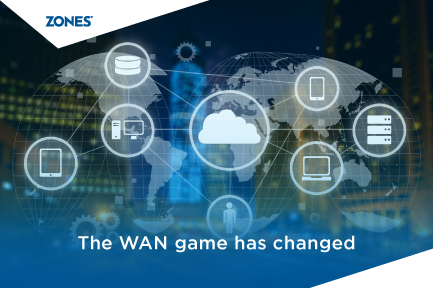3 min read
Cisco SD-WAN & Meraki – Your Networking Powerhouse
Imagine an environment where managing multiple external network connections becomes a breeze, effortlessly combining the speed of MPLS, the...
4 min read
Lawrence Van Deusen : Sep 2, 2025 2:57:16 PM

Enterprise networks are under pressure like never before. Cloud migration, hybrid workforces, and remote branches are no longer future trends they’re today’s reality. Yet, traditional WANs, built on rigid MPLS circuits, can’t keep pace. They’re costly, inflexible, and ill-suited for the cloud-first world we now live in. This is where Software-Defined Wide Area Networking (SD-WAN) steps in: a smarter, application-aware solution that redefines how businesses stay connected, secure, and agile.
This blog explores the key differences between SD-WAN and traditional WAN, outlines why it’s time to switch, and provides practical insights for businesses wanting to modernize their network strategy.
Traditional WAN typically relies on MPLS circuits to connect branch offices to a centralized data center. While known for stability and security, this setup wasn’t built with cloud applications or mobile-first workforces in mind. Every bit of traffic whether for internal systems or SaaS apps must route through the data center, causing delays and bandwidth congestion.
Additionally, managing traditional WAN infrastructures often involves dealing with multiple service providers, inflexible architectures, and manual configurations making scaling a painful and expensive endeavor.
In contrast, SD-WAN is designed with flexibility at its core. SD-WAN enables centralized management and dynamic routing based on real-time performance by decoupling the control plane from the data plane. It supports various connectivity options, including MPLS, broadband, 4G LTE, 5G, and increasingly, fixed wireless access (FWA), broadband, and even satellite links. When optimized, these alternative connections provide low-cost yet high-performance options for distributed enterprises.
With its cloud-native architecture, SD-WAN is optimized for today’s distributed enterprises, offering agility, security, and cost efficiency in one intelligent platform.
According to a global report, the SD-WAN market is projected to exceed USD 13 billion by 2025, growing at a CAGR of over 30% from 2023 to 2025. This explosive growth is fueled by digital transformation, cloud adoption, and the need for secure, scalable networking solutions.
Over 65% of multinational enterprises will have adopted SD-WAN by 2025, particularly to support multi-cloud architectures and distributed workforces.
SD-WAN has evolved beyond simple routing. In 2025, modern SD-WAN platforms will be integrated with AI/ML-powered analytics and policy enforcement, enabling application-aware routing that dynamically prioritizes mission-critical traffic and self-healing architectures that can automatically detect and remediate link issues without human intervention.
More organizations are combining SD-WAN with Secure Access Service Edge (SASE) to unify networking and security under one cloud-delivered model, enabling a zero-trust framework across every user, device, and location.
One of the most significant shifts is the emergence of SD-WAN architectures that don’t rely on the traditional underlay/overlay model. These next-gen solutions enable seamless integration between physical and virtual layers, reducing complexity while improving performance and resilience.
Additionally, the rise of Direct Internet Access (DIA) alternatives—such as fixed mobile wireless, broadband, and satellite connectivity offers enterprises new ways to connect remote sites cost-efficiently. By leveraging SD-WAN’s optimization capabilities, these links can be intelligently utilized for primary or backup connectivity, delivering high availability at a fraction of the cost of legacy MPLS.

Security has traditionally been an afterthought in WAN architectures. However, with SD-WAN, security is now a foundational feature. Modern SD-WAN platforms offer embedded firewalls, intrusion prevention, secure web gateways, and VPN capabilities.
WatchGuard’s SD-WAN overview points out that deploying an all-in-one security and networking solution simplifies operations and ensures consistent protection from headquarters to branch offices. This is especially critical as remote workers and IoT devices increase your attack surface.
Zones’ SD-WAN solutions offer integrated, enterprise-grade security features that help organizations maintain compliance while embracing agility.
Switching from traditional WAN to SD-WAN doesn’t have to be disruptive. With a strategic partner like Zones, organizations can follow a structured ADIM framework Assess, Design, Implement, and Manage to guide transformation:
Partnering with experienced professionals ensures a smoother transition and helps avoid common pitfalls—like underestimating indirect costs or excluding security stakeholders.
The world has changed and so have network expectations. Traditional WANs simply weren’t built for the demands of modern digital business. With its lower cost, cloud compatibility, integrated security, and operational agility, SD-WAN isn’t just a better option it’s the only future-ready solution.
As the SD-WAN market matures in 2025, the technology has become more robust, secure, and intelligent. It leverages AI-driven optimization, underlay/overlay-free designs, and diverse connectivity options to meet the needs of every enterprise.
Whether you're a mid-market enterprise or a global brand, SD-WAN gives you the performance edge, visibility, and flexibility to thrive.
If you’re still relying on traditional WAN architectures, you’re not just falling behind; you’re putting your business at risk of higher costs, slower performance, and increased security vulnerabilities.
Now is the time to act.
Transform your network with Zones SD-WAN Solutions secure, agile, and ready for the future.
.jpg)
3 min read
Imagine an environment where managing multiple external network connections becomes a breeze, effortlessly combining the speed of MPLS, the...

1 min read
Introduction: In an increasingly digitized world, organizations require reliable, efficient, and secure connectivity. Traditional networks often...

As corporate leaders go off in search of ways to streamline their IT in the new year, more and more of them are viewing data center transformation...